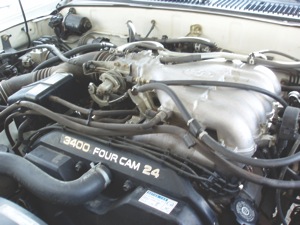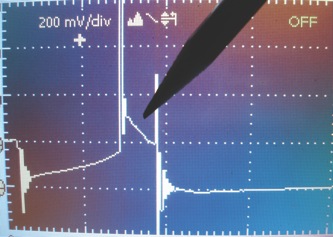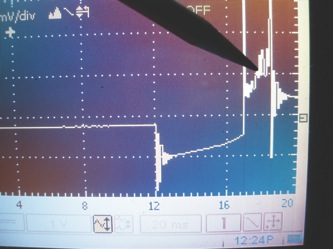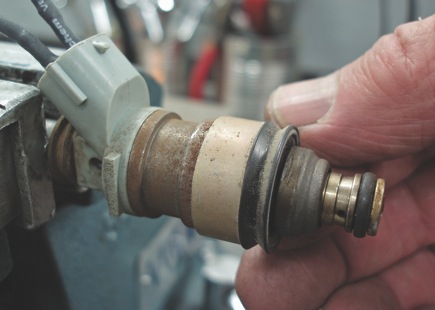
When doing mobile diagnostic work for other shops, I usually see more than my share of random no-code engine performance complaints. In the following case study, the customer of a client shop complained about an intermittent rough idle on his well-maintained 1998 Toyota 4Runner, but only when it was driven in hot weather.
During each routine service visit, my client shop couldn’t duplicate the complaint, no matter how long the engine ran. Of course, the lack of DTCs didn’t help the diagnostic process. Fortunately, I was forewarned months in advance that this problem might appear on my schedule when the weather turned warm. As expected, the shop finally duplicated the rough-idle complaint during the hot month of June. See Photo 1.
My starting point in this case was to research several databases for rough-idle complaints on 3.4L Toyota engines. One of the most common causes appeared to be insufficient valve clearance on one or more cylinders. The remaining causes consisted of the usual ignition, fuel and vacuum leak misfires. Since this rough-idle condition was so difficult to duplicate, I would classify it as a random failure, with the only predictable factor being high ambient operating temperatures.
MISFIRES AND THEIR CAUSES
Let’s review the various causes of misfires, the most common of which are ignition system misfires caused by bad ignition coils, spark plug wires, spark plug insulator flashover, eroded spark plug gaps or fouled spark plugs. In most cases, bad coils and spark plug wires with high resistance and carbon-tracked spark plugs usually worsen because heat increases the part’s electrical resistance. But these failures usually don’t require extremes in ambient temperatures, as did our Toyota’s rough-idle complaint.
Fuel distribution failures can also cause a cylinder misfire by not mixing the correct ratio of air and fuel needed for good combustion. Of course, vacuum leaks are a primary cause of rough-idle complaints on port-injected engines. Characteristically, a vacuum leak will lean out one or more cylinders at idle, but generally disappear as the engine’s throttle opens and intake manifold vacuum decreases.
Next in line for causing a rough idle might be clogged fuel injectors. Because clogging or electrical malfunctions are usually limited to one or two fuel injectors, the scan tool will often reveal bank-to-bank differences in fuel trims between cylinder banks and perhaps a marked increase in positive fuel trims at higher engine speeds.
Compression misfires might also cause a rough idle and are tricky to diagnose because they can include valve timing errors created by insufficient valve lash or worn camshaft lobes. Insufficient or “tight” valve clearance will, for example, cause a valve to open too early and close too late. Tight valve clearances will also increase valve timing overlap on the exhaust-to-intake strokes and, thus, will lose enough cranking or  running compression to cause a cylinder misfire.
running compression to cause a cylinder misfire.
A RUNNING COMPRESSION TEST
After arriving to diagnose the rough-idle problem, I immediately retrieved a DTC P0306, indicating that cylinder six was misfiring. A routine ignition scope analysis indicated that the spark plug wires were ready for replacement. The owner had left a new set of wires on the front seat, which we quickly installed. After the wires were replaced, the upward slope on cylinder six’s spark line indicated a potential fuel-related problem. More about that later. See Photos 2 and 3. 
Looking at the photo of the 3.4L engine, it’s obvious that access to the cylinder-six fuel injector and spark plug is very limited. At this point, I’m thinking that we might have a worn valve seat causing insufficient valve lash, so I experimented with recording some vacuum waveforms with no result. A running compression test comparing cylinders five and six proved my theory to be wrong.
On each cylinder, the engine idled at 80 psi and achieved 160 psi during a snap throttle test. Keep in mind that, at my 8,000-ft. altitude, those readings are about 20% low. Because the snap-throttle readings were identical, I dismissed insufficient valve lash as a cause of the rough-idle complaint.
As a sidelight, I also should have remembered that aluminum cylinder heads tend to increase valve lash as they warm up, whereas cast-iron cylinder heads tend to decrease valve lash during warmup. The reason for this phenomenon is because the aluminum cylinder head expands roughly 1.5 times more than the steel valves and valvetrain at any given temperature change.
SCAN TOOL TESTING
I recently bought a new scan tool, so I had to familiarize myself with all of its features and menus. At this point, I noticed a 13.5% positive short-term fuel trim. I hadn’t noticed that condition before, but the engine warming up for at least 30 minutes not only verified the customer’s complaint of a rough idle when hot, but now also gave me a number to work with.
Going with the misfire history, I also noticed that cylinder six was misfiring 38 times, compared to four times for cylinder one and eight times for cylinder five. Keep in mind that, because cylinder five fires immediately before cylinder six, and cylinder one fires immediately after cylinder six, the cylinder one and five misfires were likely “sympathetic” misfires that were actually caused by fuel distribution problems created by the cylinder six fuel injector not firing.
As I mentioned above, the spark line on the ignition waveform on cylinder six indicated a possible lack of fuel. Just to ensure that we weren’t having a spark plug problem, we had switched cylinder five and six spark plugs during the running compression test, only to observe identical results.
While I don’t want to get into the aftermarket/OEM scan tool debate, aftermarket scan tools obviously don’t include the range of features provided by OEM tools. But, because of advances in their platform technologies, more aftermarket tools are including more OEM functions than ever before. Consequently, I began thumbing through my new scan tool’s various menus until I reached a menu for bi-directional tests. Fortunately, I found a bi-directional test that actually increased the short-term fuel trim by 25%.
After activating the fuel trim test, the rough-idle condition nearly disappeared. Given that my initial labscope test had indicated an upward slope on the ignition waveform spark line and that the bank one fuel trim was hovering around plus 13.5%, I decided that the cylinder six fuel injector was either clogged or had  developed an electrical problem that prevented it from opening on command.
developed an electrical problem that prevented it from opening on command.
Since the complaint occurred only at higher ambient temperatures, it likely was an electrical failure causing the injector to misfire. At this point, I would have loved to access the PCM and check the injector waveform on the cylinder six fuel injector. But given the time limitations of working on another shop’s schedule, I closed by recommending the replacement of the cylinder-six fuel injector. See Photo 4.
After I took the defective injector home for more testing, I found that, while the resistance specifications are 13.4 ohms minimum and 14.2 ohms maximum, this injector bounced from 165 to 400 ohms at room temperature, and to as much as 1,200 ohms at 200° F. On a colder day, the injector would probably carry enough amperage to partially open the injector pintle valve. Once the injector’s core temperature reached 200° F, it would no longer fully open the injector’s pintle valve, thus causing the no-code, rough-idle complaint.




